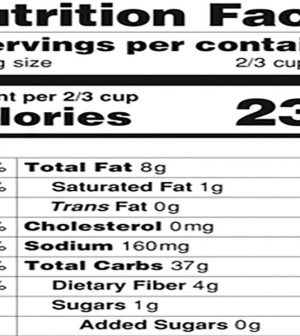- Navigating Your Midlife Crisis: Embracing New Possibilities
- City Raccoons Showing Signs of Domestication
- Mapping the Exposome: Science Broadens Focus to Environmental Disease Triggers
- One Week Less on Social Media Linked to Better Mental Health
- Your Brain Changes in Stages as You Age, Study Finds
- Some Suicide Victims Show No Typical Warning Signs, Study Finds
- ByHeart Formula Faces Lawsuits After Babies Sickened With Botulism
- Switch to Vegan Diet Could Cut Your Greenhouse Gas Emissions in Half
- Regular Bedtime Does Wonders for Blood Pressure
- Dining Alone Could Mean Worse Nutrition for Seniors
Be Sure to Read Labels for Portion, Calorie Control

“Nutrition Facts” labels mandated by the U.S. Food and Drug Administration have made it easier to know more about what’s inside packaged foods. But the information isn’t always easy to decipher, especially since the “daily value” percentages are based on a maintenance diet, not a weight-loss one.
Start by looking at the number of servings in the package and the calories in each of those servings. Realize that if the calorie count is low because the serving size is very small, one portion may not satisfy you.
Next, look at the nutrients. Fat grams deliver twice the calories of protein and carbs, so keep them in check. Limit saturated fat if your doctor has told you that’s important. Choose items that have already eliminated trans fat, a step that must be taken by food manufacturers by mid-2018.
Many people get their protein from sources like chicken and fish that don’t have nutrition labels. If you’re a vegetarian, pay close attention to the protein grams when choosing grains and legumes. Check fiber grams, too — more fiber is more filling and boosts digestive health.
Though vitamins and minerals don’t factor into calories, make sure you’re getting enough of the vitamins A and C, and the minerals calcium and iron, nutrients often lacking in the American diet.
The FDA has approved an updated design for the standard nutrition label that makes it easier to see the portion size, calorie count and number of portions in packaged items. But the agency recently delayed the compliance date for the new labels from 2018 until 2020 for large food manufacturers and 2021 for small ones.
So, until then, you’ll need to be more vigilant about reading between the lines on the current labels.
More information
Highlights of the final Nutrition Facts Label on the FDA website will help you know what to look for on current labels.
Source: HealthDay
Copyright © 2025 HealthDay. All rights reserved.










